?最近在学习数据库索引,所以在这里记录下最近的学习心得。
?
? ?热身学习。
? ? ?1.二叉平衡树和B树B+树的概念需要了解。
? ? ?2.了解二叉平衡树的旋转。
? ? ?3.思考为何数据库索引不使用二叉平衡树而选择B树或者B+树。
? ? ?4.思考B+树作为索引相对于B树的优点在哪里。
?
? ?知识总结
? ? ? 1.聚集索引
?
? ? ? ? ?叶子节点包含聚集键值和全部数据。
?
? ? ? ? ?表中的数据顺序通过聚集键的顺序来维护,聚集索引树本身就包含了一个表。
? ? ? ? ? ? ? ? 单独的外链双链表来进行页之间的维护。也就是说在每页中是有序的,每个页也是有序的。
?
? ? ? ? 思考,那如果页的最后一条数据添加或者删除会有哪些情况?
?
? ? ? ? 思考,聚集键值唯一性,宽度,易变性因素对整个索引产生的影响。
? ? ? ? ? ? ? ? ? 唯一性在下面的问题中探讨。
? ? ? ? ? ? ? ? ? 宽度的影响首先影响本身B树的每个节点的度,其次辅助索叶子节点引用键值的成本增加。
? ? ? ? ? ? ? ? ?易变性使其记录需要重新定位,容易产生页面分离和碎片。其次每个辅助索引需要修改。
?
? ? ? ? 思考,通过聚集键找到叶子节点的时候,将叶子节点的页面加载进来的时候是通过二分查找吗?
?
?
??
?
?
? ? ?2.非聚集索引
?
? ? ? ?叶子节点存储的是索引键值和【聚集键或者sqlserver生成物理标示符RID】
?
? ? ? ?思考RID是sqlserver自动生成的,还是真实物理地址。?
? ? ? ? ? ? ? 真实的物理行号。
?
? ? ? ?思考,为何聚集键值必须唯一。
? ? ? ? ? ? ? 假设聚集键值不唯一,聚集键为姓名,非聚集键值为身份证号,如果一个非聚集索引是唯一的如身 ? ? ? ? ? ? ? ? 份证号,定位到一个姓名A如果存在多个人姓名为A则更新的是跟新多个人的姓名是不合理的,因为 ? ? ? ? ? ? ? 身份证号是唯一的。
?
? ? ? ?如果聚集键不一定则sqlserver会在必要时添加一个隐藏的唯一标识列来保证内部的唯一性。
?
? ? ? 思考索引和约束有哪些区别?
? ? ? ? ? ? ?索引会建立真实的物理结构需要维护,而索引则是逻辑上的意义。
?
? ? ?3.索引结构
?
?
?
? ? ? ? 对于聚簇索引表的聚簇索引结构如下。
? ? ? ? ?
-- 创建聚簇索引表create table employee( id int not null identity, lastname Nchar(30) not null, firstname nchar(29) not null, middleinit nchar(1) null, ssn char(11) not null, othercolumns char(258) not null default 'jack');alter table employee add constraint employeePK primary key clustered (id) select * from employee-- 80000条insert into employee(lastname,firstname,middleinit,ssn,othercolumns) values('','','','','')-- 查询索引结构select index_depth as 'Depth' ,index_level as 'Level' ,record_count ,page_count ,avg_page_space_used_in_percent as 'pgPercentFull' ,min_record_size_in_bytes as 'minLen' ,max_record_size_in_bytes as 'maxLen' ,avg_record_size_in_bytes as 'avgLen' from sys.dm_db_index_physical_stats(DB_ID('test'),OBJECT_ID('employee'),1,null,'detailed')? ???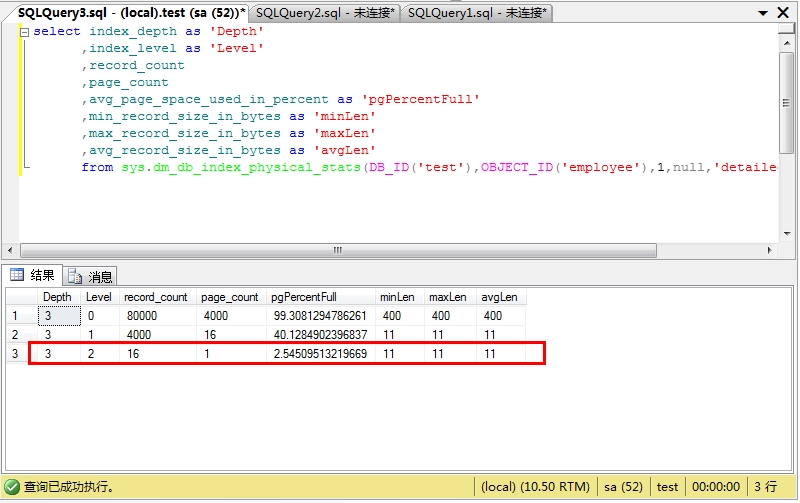
?
dbcc page ( {'dbname' | dbid}, filenum, pagenum [, printopt={0|1|2|3} ])The filenum and pagenum parameters are taken from the page IDs that come from various system tables and appear in DBCC or other system error messages. A page ID of, say, (1:354) has filenum = 1 and pagenum = 354.The printopt parameter has the following meanings:0 - print just the page header1 - page header plus per-row hex dumps and a dump of the page slot array (unless its a page that doesn't have one, like allocation bitmaps)2 - page header plus whole page hex dump3 - page header plus detailed per-row interpretationdatabase consistenecy checker,简称dbccTrace flag 3604 is to print the output in query window. Since you have not given -1 parameter (DBCC TRACEON(6304,-1)), it would be session specific. Once you close the window, it would be cleared. ?
?
?
-- 寻找12345的记录。--创建临时表create table temp_table( PageFID tinyint, pagePID int , IAMFID tinyint, IAMPID int, objectID int, indexID tinyint, partitionNumber tinyint, partitionID bigint, iam_chain_type varchar(30), pagetype tinyint, indexLevel tinyint, nextpageFID tinyint, nextpagePID int, prePageFID tinyint, prepagePID int, primary key(PageFID,PagepID))--寻找索引idselect * from sys.sysindexes where name='employeePK'--查询dbcc ind结果集--此处需要索引IDtruncate table temp_tableinsert temp_table exec ('dbcc ind (test,employee,1)') -- 找到根页select indexLevel, PageFID, pagePID, prePageFID, prepagePID, nextpageFID, nextpagePID from temp_table order by indexLevel desc,prepagePID--查询根页的记录开始B树搜索--LEVEL 2dbcc page('test',1,1695,3)--LEVEL 1dbcc page('test',1,1966,3)--LEVEL 0dbcc traceon(3604)dbcc page('test',1,1690,3)??
? ? 根据索引名称获取索引ID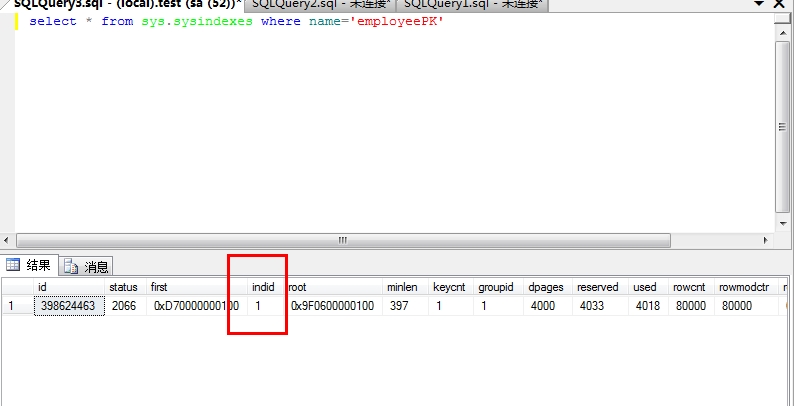
?
?
?根据索引ID找到级别2的Root页号?
?
? ? 查询级别2的页内容,定位级别1的页号。
? ? ?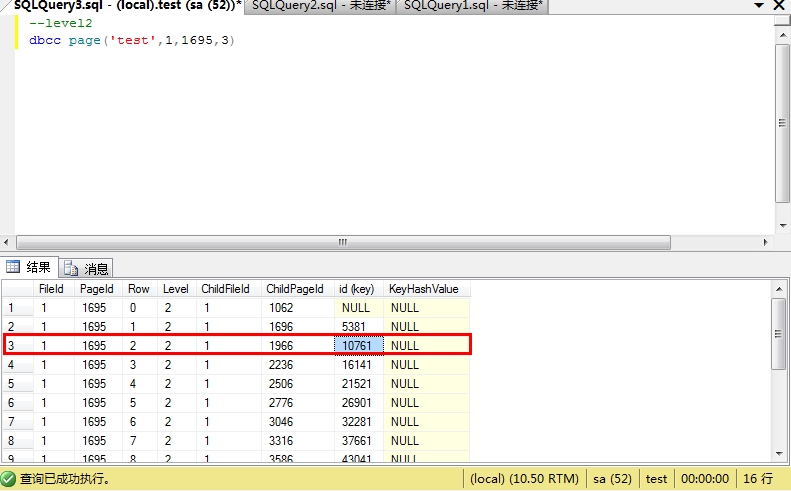
根据级别1的页号,查询级别1的内容,定位叶子节点的页号。?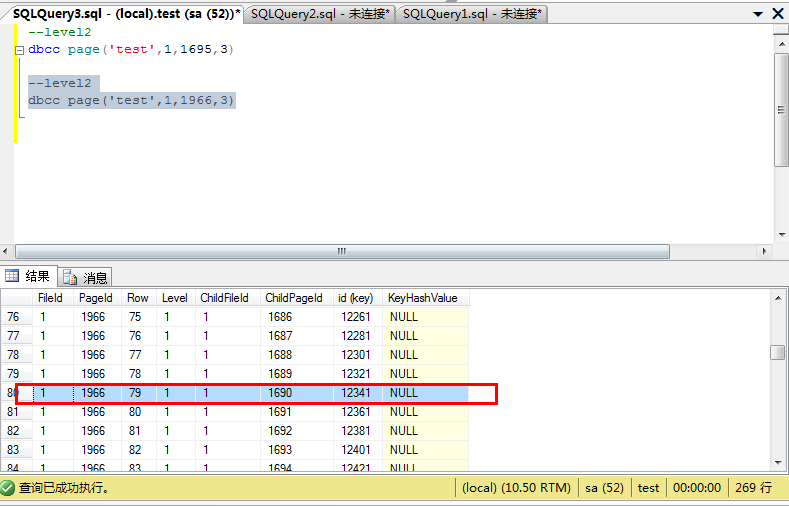
?
?
根据叶子节点的页号,查询叶子节点的内容。?
? ? ?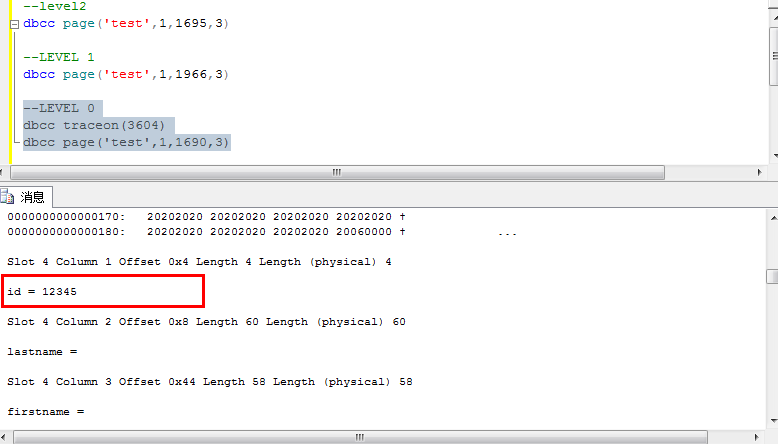
?
?
? ??
?
?
?
?
?
?
?
?聚簇索引表的非聚簇索引结构。
? ??
-- 修改原来的聚簇索引表结构update employee set ssn = CAST(id as char(8))+'ssn'--添加UK索引alter table employee add constraint employeeSSNUK unique nonclustered (ssn)--还是查找12345-- 查询索引结构 select index_depth as 'Depth' ,index_level as 'Level' ,record_count ,page_count ,avg_page_space_used_in_percent as 'pgPercentFull' ,min_record_size_in_bytes as 'minLen' ,max_record_size_in_bytes as 'maxLen' ,avg_record_size_in_bytes as 'avgLen' from sys.dm_db_index_physical_stats(DB_ID('test'),OBJECT_ID('employee'),2,null,'detailed')--寻找索引ID 2select * from sys.sysindexes where name='employeeSSNUK'-- 查询结果集truncate table temp_tableinsert temp_table exec ('dbcc ind (test,employee,2)') -- 找到根页fID,pageIDselect indexLevel, PageFID, pagePID, prePageFID, prepagePID, nextpageFID, nextpagePID from temp_table order by indexLevel desc,prepagePID--查询根页内容找到叶子节点的页号dbcc page('test',1,13216,3)--查询叶子节点的内容 存储的是聚集键dbcc traceon(3604) dbcc page('test',1,9037,3) ??
? ? 查询索引结构
? ?
?
查询索引ID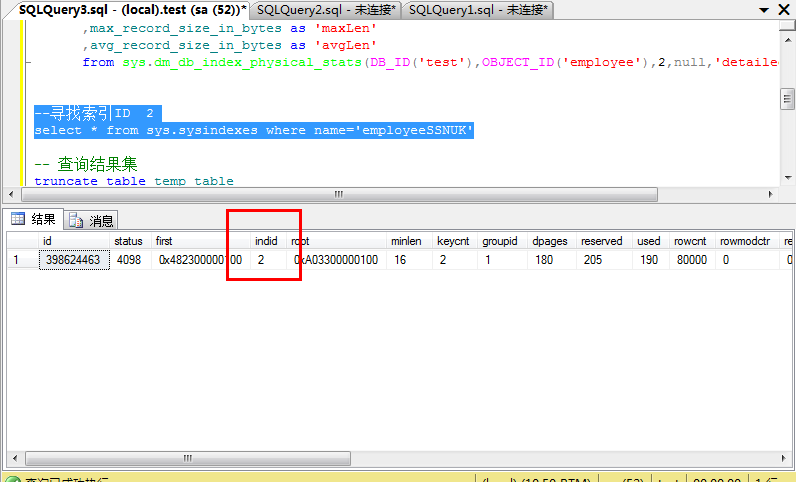
?
寻找根页号需要fID和pageID
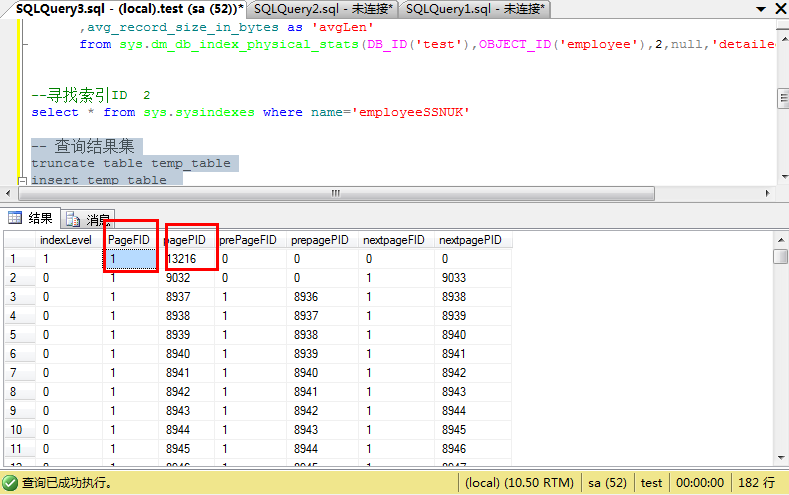
?
查询根页内容,根据范围寻找叶子节点的页号。
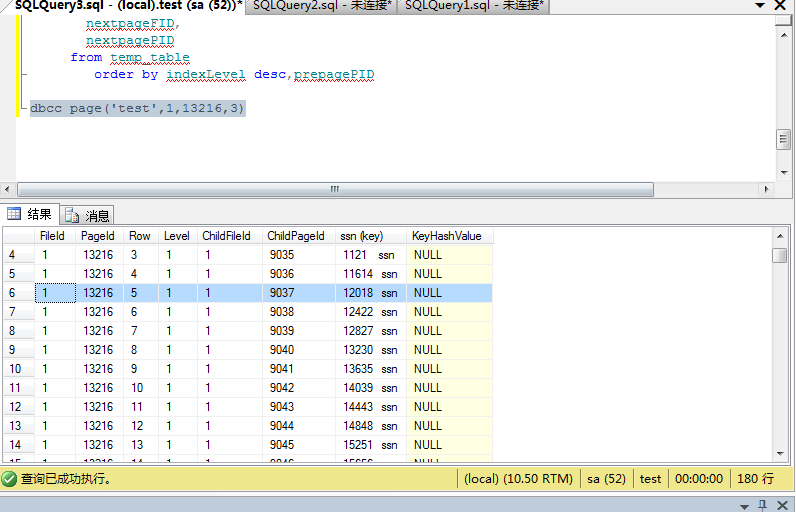
?
?
?
?查询叶子节点的内容。
?
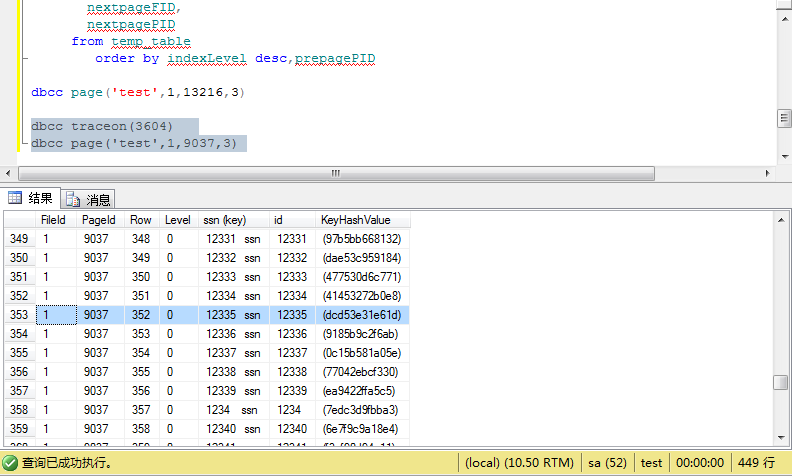
?
?
?
?
?
关于堆表索引结构
?
--创建堆表create table employeeHeap( id int not null identity, lastname Nchar(30) not null, firstname nchar(29) not null, middleinit nchar(1) null, ssn char(11) not null, othercolumns char(258) not null default 'jack'); alter table employeeHeap add constraint employeeHeapPK primary key nonclustered (id)--查询索引IDselect * from sys.sysindexes where name='employeeHeapPK'-- 查询索引的结构select index_depth as 'Depth' ,index_level as 'Level' ,record_count ,page_count ,avg_page_space_used_in_percent as 'pgPercentFull' ,min_record_size_in_bytes as 'minLen' ,max_record_size_in_bytes as 'maxLen' ,avg_record_size_in_bytes as 'avgLen' from sys.dm_db_index_physical_stats(DB_ID('test'),OBJECT_ID('employeeHeap'),3,null,'detailed') truncate table temp_tableinsert temp_table exec ('dbcc ind (test,employeeHeap,3)') -- 查找12345 步骤-- 找到根页select indexLevel, PageFID, pagePID, prePageFID, prepagePID, nextpageFID, nextpagePID from temp_table order by indexLevel desc,prepagePID --level 1 7888dbcc page('test',1,7888,3)--查看叶节点的内容dbcc page('test',1,7830,3)-- 创建解析函数create function convert_rids (@rid binary(8)) returns varchar(30)as begin return ( convert (varchar(5), convert(int,substring(@rid,6,1) +substring(@rid,5,1))) +':'+ convert(varchar(10),convert(int,substring(@rid,4,1) +substring(@rid,3,1)+substring(@rid,2,1)+substring(@rid,1,1))) +':'+ convert(varchar(5),convert(int,substring(@rid,8,1)+substring(@rid,7,1))) ) end--fileID,pageID,slotNum 解析rid select test.dbo.convert_rids(0x5126000001000400)--查看行的内容dbcc traceon(3604) dbcc page('test',1,9809,3) ??
? ? 查询索引ID
? ??
?
? 根据索引ID查看索引结构
??
?
?
?根据索引ID获取根页号
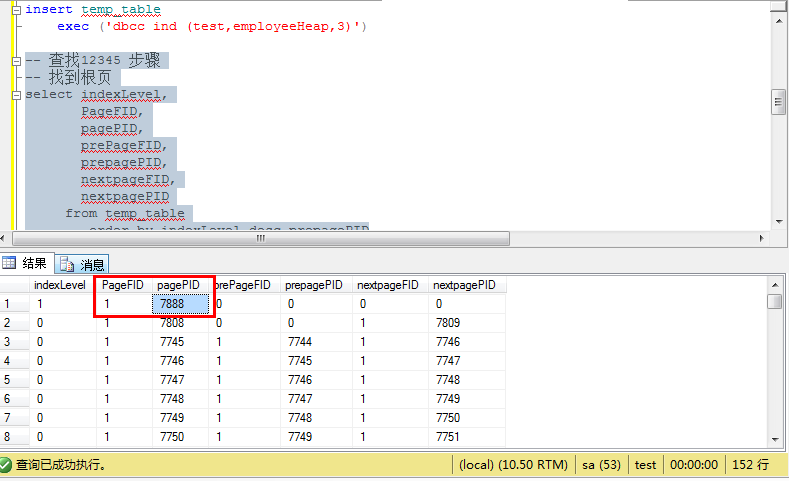
?
查看根页的内容获取子节点的fID和pageID

?
?
根据根页提供的pageID查看叶子节点的内容
叶子节点存储的是物理行号,

?
?
?解析行号。
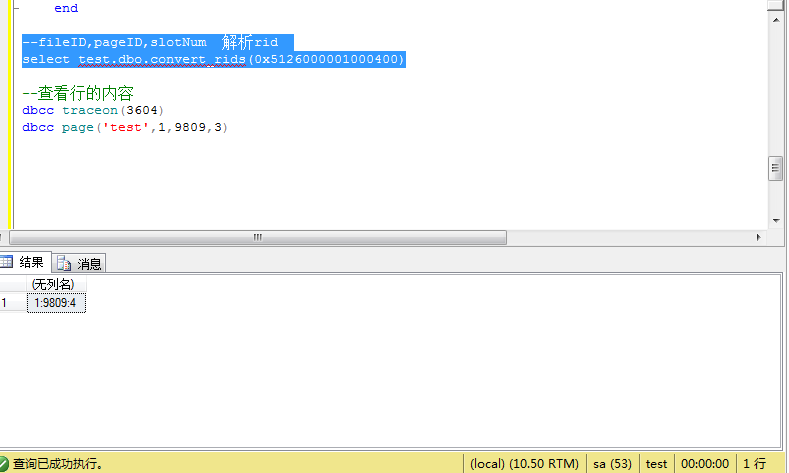
?
?
?
查看行数据。
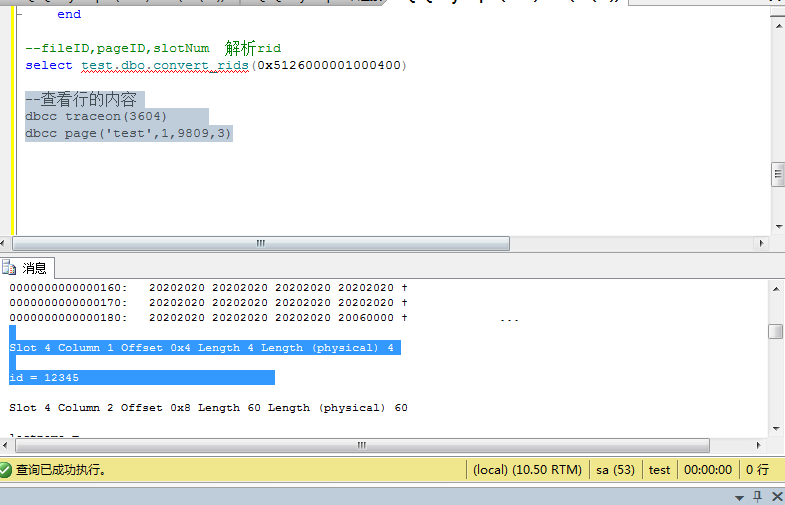
?
?
?
?
?
?
?
?
?
?
?
?
?